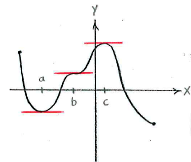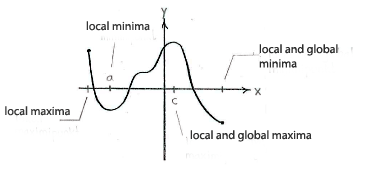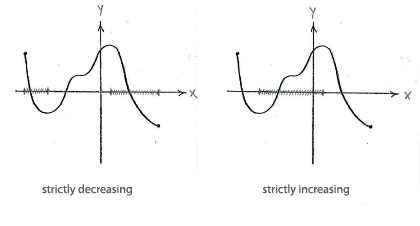Solution 1.3:1c
From Förberedande kurs i matematik 2
m (Robot: Automated text replacement (-[[Bild: +[[Image:)) |
m |
||
| (2 intermediate revisions not shown.) | |||
| Line 1: | Line 1: | ||
| - | + | The function has zero derivative at three points, <math>x=a</math>, <math>x=b</math> and <math>x=c</math> (see picture below), which are therefore the critical points of the function. | |
| - | < | + | |
| - | + | ||
| - | + | ||
| - | < | + | |
| - | + | ||
| - | + | ||
| - | < | + | |
| - | + | ||
[[Image:1_3_1_c1.gif|center]] | [[Image:1_3_1_c1.gif|center]] | ||
| + | |||
| + | The point <math>x=b</math> is an inflexion point because the derivative is positive in a neighbourhood both to the left and right. | ||
| + | |||
| + | At the left endpoint of the interval of definition and at <math>x=c</math>, the function has local maximum points , because the function takes lower values at all points in the vicinity of these points. At the point <math>x=a</math> and the right endpoint, the function has local minimum points. | ||
| + | |||
| + | Also, we see that <math>x=c</math> is a global maximum (the function takes its largest value there) and the right endpoint is a global minimum. | ||
| + | |||
[[Image:1_3_1_c2.gif|center]] | [[Image:1_3_1_c2.gif|center]] | ||
| + | |||
| + | Between the left endpoint and <math>x=a</math>, as well as between <math>x=c</math> | ||
| + | and the right endpoint, the function is strictly decreasing (the larger <math>x</math> is, the smaller <math>f(x)</math> becomes), whilst the function is strictly increasing between <math>x=a</math> and <math>x=c</math> (the graph flattens out at <math>x=b</math>, but it isn't constant there). | ||
| + | |||
[[Image:1_3_1_c3.gif|center]] | [[Image:1_3_1_c3.gif|center]] | ||
Current revision
The function has zero derivative at three points, \displaystyle x=a, \displaystyle x=b and \displaystyle x=c (see picture below), which are therefore the critical points of the function.
The point \displaystyle x=b is an inflexion point because the derivative is positive in a neighbourhood both to the left and right.
At the left endpoint of the interval of definition and at \displaystyle x=c, the function has local maximum points , because the function takes lower values at all points in the vicinity of these points. At the point \displaystyle x=a and the right endpoint, the function has local minimum points.
Also, we see that \displaystyle x=c is a global maximum (the function takes its largest value there) and the right endpoint is a global minimum.
Between the left endpoint and \displaystyle x=a, as well as between \displaystyle x=c and the right endpoint, the function is strictly decreasing (the larger \displaystyle x is, the smaller \displaystyle f(x) becomes), whilst the function is strictly increasing between \displaystyle x=a and \displaystyle x=c (the graph flattens out at \displaystyle x=b, but it isn't constant there).



